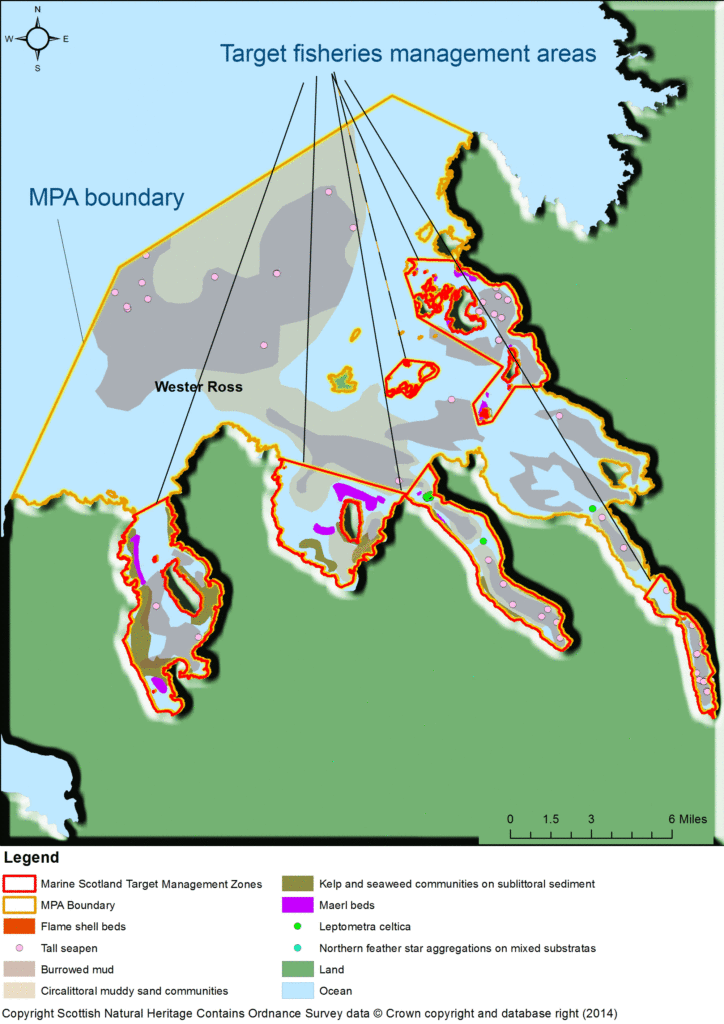The Wester Ross MPA was put forward as a 3rd party community proposal and is of clear cultural and socio-economic importance to the proponents. This area has historically boasted a rich and diverse marine ecosystem and, while many key species and habitats are still found within the MPA, local residents and marine users have witnessed first-hand the impacts caused by damaging activities and a decline in biodiversity.
Target areas of management, developed as part of Marine Scotland’s 2014 fisheries displacement study[1], zoned off Lochs Broom and Ewe, Gruinard Bay and parts of the Summer Isles from the use of bottom-towed mobile fishing gear and applied a vessel capacity restriction throughout the MPA. These measures would afford protection from damaging fishing gears for an estimated 25% of the site, leaving the remaining 75%, which primarily consists of burrowed mud and the delicate component species that inhabit it, still exposed to these impacts. Additionally, these proposed management measures specify nothing to explicitly protect at least half many of the features for which the MPA has been designated, including northern feather star, kelp and seaweed communities or circalittoral muddy sand communities. While some of the potential zonal prohibitions and site-wide capacity restriction may provide consequential protection, many of the features play a key role in the local ecosystem (e.g.such as fish spawning areas) and merit more focused protection.
Furthermore we are concerned that, by restricting the targeted no-trawl zones to the inner areas of the MPA site, there is little scope for long-term benefits of protection to be realised in the wider Scottish sea area. Many species are only capable of larval dispersal or colonisation over short distances and, with proposals of a continuation of fishing throughout the rest of the site (albeit with a restriction on capacity), we contend that the benefits of biodiversity spillover outside the MPA are unlikely to be realised.
It is clear from Figure 1 that within the majority of the burrowed mud feature included in the estimated 75% of the MPA that will still be exposed to bottom-towed fishing gears, one quarter of tall sea pens (one of many sensitive component species of burrowed mud) in this site, have not been included in the potential no-trawl zones. These slow growing inhabitants of burrowed mud are easily broken or removed by a single pass of a trawl and excessive pressure from bottom-towed fishing gear on what is normally a low-energy stable habitat can reduce sediment complexity and result in a habitat unable to properly support its characteristic level of species biodiversity[2].
Most notably in the Wester Ross MPA, maerl beds (an important coralline habitat for a variety of marine species that attach to or live amongst the surface features) have been assigned a conservation objective of ‘recover’. Given that SNH have acknowledged these features to be in poor condition in this area, it is concerning that recommended target management zones within the Wester Ross MPA do not include the full extent of live maerl indicated in SNH’s most recent research paper[3] on maerl (e.g. P18, Figure 10), as is also the case for the SFF’s zonal voluntary measures. OSPAR guidelines[4] for maerl stipulate that this feature is defined by living and dead maerl (‘maerl gravel’) and a mixture of both, all of which must be adequately protected to allow recovery of this feature. Given that the proposed and voluntary zonal management zones do not include the full extent of maerl, and that maerl can take decades to recover following disturbance by bottom-towed mobile fishing gears[5], it is unlikely the conservation objectives for this site can be achieved under management outlined in the fisheries.
The Scottish Government must carefully consider the ambition for management within the MPAs and ensure that nature conservation and enhancement, the very objectives of the MPA network, are fully prioritised as management measures are developed.
[1] http://www.scotland.gov.uk/Resource/0044/00443500.pdf
[2] Greatead, D. F., Donnan, D. W., Mair., J.M. and Saunders, G.R. (2007) The sea pens Virgularia mirabilis, Pennatula phosphorea and Funiculina quadrangularis: distribution and conservation issues in Scottish waters. Journal of the Marine Biological Association of the UK 87, 2095-1103
[3] http://www.snh.org.uk/pdfs/publications/commissioned_reports/764.pdf
[4] OSPAR 2010. Background document for Maërl beds. OSPAR Commission: London
[5] JM Hall-Spencer, PG Moore (2000) Scallop dredging has profound, long-term impacts on maerl habitats. ICES Journal of Marine Science: Journal du Conseil 57 (5), 1407-1415

